|
 Hygrocybe blanda Hygrocybe blanda
BiostatusPresent in region - Indigenous. Endemic
Images (click to enlarge)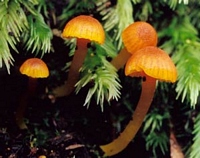
Caption: Hygrocybe blanda
Owner: Kaimai Bush | 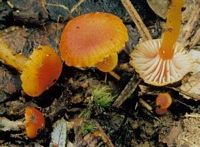
Caption: Hygrocybe blanda
Owner: Kaimai Bush | 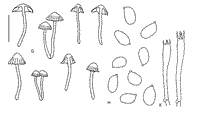
Caption: Fig. 3 Hygrocybe blanda Horak (A-C: PDD 27185, type): G.
basidiomesH. spores. K. basidia | 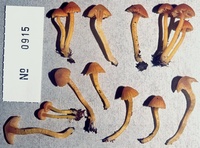
Caption: ZT0915 , Holotype
Owner: E. Horak: © Creative Commons Attribution-Noncommercial 3.0 New Zealand | 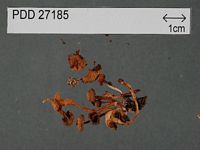
Caption: Dried type specimen
Owner: Herb PDD |
Article: Horak, E. (1990). Monograph of the New Zealand Hygrophoraceae (Agaricales). New Zealand Journal of Botany 28(3): 255-306 (http://www.rsnz.org/publish/abstracts.php).
Description: Pileus -18 mm, hemispherical becoming obtusely conical or broadly campanulate,
margin not upturned, lobate-sulcate in mature specimens; brilliant orange (but
any red colours absent) or orange-yellow; dry, hygrophanous, conspicuously striate
in wet condition, smooth. - Lamellae 6-10 (1 -1) broadly adnate to subdecurrent
with short tooth, rather distant pale orange-yellow turning pale orange in aged
basidiomes, entire obtuse edges concolorous. - Stipe 15-30 x 1.5-2 mm, cylindrical,
equal or gradually enlarged into pileus; orange yellow in upper portion, golden
yellow below; dry,minutely fibrillose, fistulose-hollow, single or caespitose.
- Context orange in pileus, yellow in stipe. - Odour and taste not distinctive.
- Chemical reactions on pileus: KOH - negative. - Spore print white.
Spores 5.5-7 x 4-4.5 (-5) um, elliptical to ovoid, hyaline, smooth, inamyloid.
- Basidia 40-45 x 5um, 4-spored. - Cystidia absent. - Pileipellis a cutis of
cylindrical, non-gelatinised hyphae (2-6um diam.), with pale yellow (KOH) plasmatic
and encrusting pigment, oleiferous hyphae present; clamp connections present
(Pl. 1, Fig. 4, 7).
Habitat: ECOLOGY. Rare; on soil among moss and litter in mixed moss forest. June.
Distribution: DISTRIBUTION: NZ (NA-LBI).
Notes: ETYMOLOGY: blandus = attractive.
The yellow-orange basidiomes with no trace of red colours and the decurrent
lamellae relate Hygrocybe blanda to both H. firma and H.
cerinolutea. Microscopically, however, the identification of H. blanda
is readily achieved. The spores of this taxon measure only 5.5-7 um and thus
are much smaller than those reported for the latter two species. Also the size
of the basidia significantly separates H. blanda from its similar-looking
relatives.
|